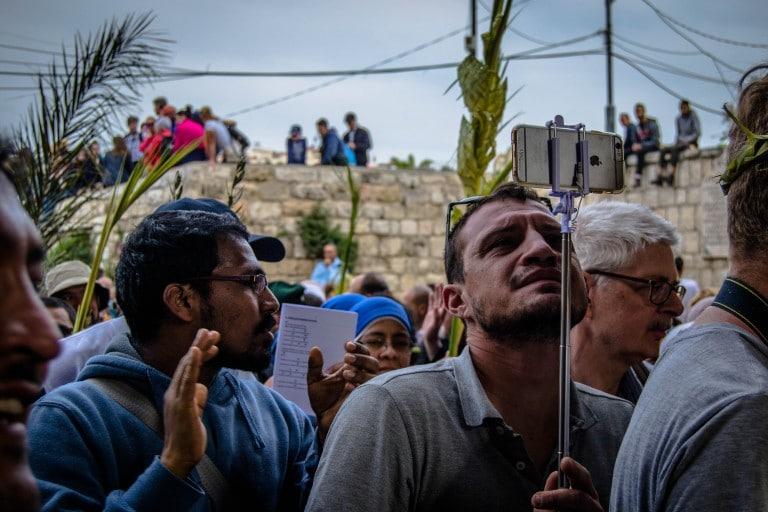The procession of the Palm Sunday is probably one of the most important manifestations for the Catholics of the Holy Land and it also recalls many pilgrims from all over the world. This one is indeed an unique occasion to walk with your own congregation on the path Jesus took for his triumphal entry in Jerusalem. This very peculiar year not many people will be able to take part to the celebration: religious, Catholics from Jerusalem and Nazareth, maybe someone coming from Bethlehem, the scout’s band with bagpipes and tambourines but no pilgrims at all. “It will be a moment to make music, sing and cry out loud at the world that here we are, we made Jesus’ revolutionary message of love ours” the Holy Land devotees told us.
The starting point will be at the Franciscan church in the village of Bethphage, here where the apostles found a foal of a jennet that was never used by anyone as it was destined for Jesus to ride so he could fulfill the prophecy made by Zachary 500 years before: “Rejoice greatly, Daughter Zion! Shout, Daughter Jerusalem! See, your king comes to you, righteous and victorious, lowly and riding on a donkey, on a colt, the foal of a donkey” (Zachary 9, 9). During the construction of the church in 1883, a mysterious huge squared stone was found. Its sides decorated with frescos of a vivid blue, red, yellow, green and violet: on the South side Martha, Mary and Lazarus being brought back to life can be seen, on the North side the colt being freed and on the East side a joyful party waving palm branches, used for royal parades. The huge stone was part of the original crusades’ byzantine church and from here, starting from the 12th Century, the first processions of the palm Sunday took place and headed towards Jerusalem: to re-experience the episode narrated in the Gospel is a very ancient tradition.
From the church, big enough for the religious authorities but not for the pilgrims that usually star the procession from the Carmelite Monastery of the Pater Noster, you will have to descend from the Mont of Olives along the side of the Gethsemane complex. Gethsemane literary means “olives’ press” and here you will find eight centenarian olive trees planted 800 years ago by crusaders. All of them are healthy and they come from the same root, probably the one belonging to a tree regarded as the a testimony of Jesus’ passion already in the past. Something curious about palms and olive trees branches used during the procession: the tradition comes from the Jewish feast of Sukkot, the feast of the tabernacles related to spring, the one where devotees walk to the Temple with a wrap of four plant species (palm, mirth, willows and the fruit of a citron tree). In Jerusalem palm is the most popular choice and big, vivid green palms are waved during the procession. In Italy and many European countries, olive branches are used instead of palms. They are blessed during the mass and gifted as a symbol of peace to family members.
Beneath the olive trees garden, contrasting with the luscious greenery, you will see a sea of rocks made by the gravestones of the Jewish cemetery. Here the view is amazing: behind the Old City walls, the glimmering gold of the dome of the Rock. Palm Sunday in Jerusalem is usually a lovely sunny day of Spring and this year it won’t be different. The path of the procession is short, only 2 km and a half on a descent, walked slowly with frequent stops to sing and pray. Sometimes it is a bit uncomfortable to walk as it pass through some of the most chaotic and modest Muslim neighborhoods. Finally it’s time to enter in the city of Jerusalem passing through the Lion’s Gate, a huge stone structure decorated with panther statues. It is the only gate still open on the East side of the city’s walls. Jesus did not pass through this gate but probably from one standing where the Golden Gate is. The gate gets you directly to the Temple Mount and it is still sealed.
Here the procession will be more populated, more loud and happier than ever, enough to wake up the sleepy average weekend day of the residents of the Muslim neighborhood where the last stop of the procession is: the church of Saint Anne. The palm branches are waved again and the crowd will shout out in a festive tone: “Hosanna! Blessed is he who comes in the name of the Lord! Blessed is the coming kingdom of our father David! Hosanna in the highest heaven!” (Mark 11, 1-10).












